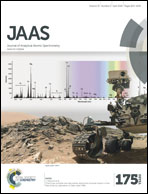Ultratrace analysis of krypton isotopes by resonant ionization spectroscopy-time of flight mass spectrometry (RIS-TOF)
Abstract
A new RIS-TOF instrument, called FAKIR (Facility for Analyzing Krypton Isotope Ratios), has been developed at CENBG in order to measure Kr isotope ratios with an extremely high sensitivity. The instrument uses a single color Kr ionization scheme with tunable coherent UV photons near 216.6 nm. A two-photon resonance excitation allows it to reach the 5p[5/2]2 excitation level followed by a single-photon ionization. Krypton ions are accelerated towards an electron multiplier. The instrument includes a cryogenic concentrator that increases the efficiency of the ion source and a new selecting system allowing the deflection of the abundant isotopes before they impact the detector. This device eliminates the blinding effect on the detector that alters the detection of the less abundant Kr isotopes. The current sensitivity of the instrument of ∼6700 atoms has been demonstrated by extracting the gas from 37 mg of the Boguslavka iron meteorite. The associated errors on the 81Kr isotope ratio measurements did not exceed ∼12%. A good agreement is observed with conventional mass spectrometry analysis, which requires several grams of material, by measuring the cosmic ray exposure age of the Boguslavka meteorite.


 Please wait while we load your content...
Please wait while we load your content...